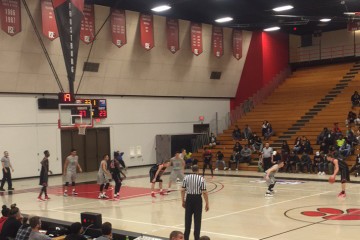FSU Officials Lobby Maryland General Assembly for Education and Health Science Building, Infrastructure Improvement
Frostburg State University officials are lobbying the Maryland General Assembly to acquire funding for a new Education and Health Sciences building, as well as $2 million for biennial infrastructure improvement.
Dr. John Bowman, who was named FSU’s interim vice president for government relations in July 2015, and Dr. Tom Bowling, the university interim president, have been the driving forces during the current legislative session.
At the top of the university’s agenda was funding for a new building for education and health sciences. Bowman said that he told legislators, “We really need a new education and health science building.”
“Our health sciences curriculum and programs are growing and will continue to grow in the future,” Bowman told The Bottom Line in an interview. “This institution is known throughout the state of Maryland for the quality of the college education and the programs that it offers, both at the undergraduate and graduate levels,” he added, explaining the the university has a statewide reputation for producing quality teachers.
“We need a facility worthy of that reputation, which is outstanding,” he said. “We need a facility that will help us continue to grow.”
That building is in the Governor’s capital project queue for planning in 2019. Officials have been trying to move the building up in the queue, but it has not been moved up. However, Bowman said that some statewide projects have been delayed or removed from the queue altogether. This building has not been delayed or removed.
David Rose, FSU’s vice president for administration and finance, said, “I would expect that funding to remain in the budget.”
FSU’s latest capital project, a new public safety building is currently in the planning stage, according to Rose, and construction will likely begin towards the end of April 2016. The public safety building will probably be built in the parking lot adjacent to Lowndes Hall, according to Rose.
Officials have also requested funding for infrastructure maintenance and improvement.
“We have also asked for infrastructure money – it’s called the Campus Wide Building and Infrastructure Improvements Request,” Bowman said. “We have for several years, asked for $2 million, every other year, for infrastructure improvements.”
“We need a building like the education and health sciences building, but we also need money so that we can continue to maintain our facilities,” he said.
Bob Boyce, the director of FSU’s physical plant, said, “We have a lot of older buildings with many systems which need to be updated or replaced in total. When you think of all of our rooves, sidewalks, parking lot pavement, roadways, elevators, HVAC systems, fire alarms, underground electrical distribution, water, sewer and natural gas lines you need a ton of money to make an impact. We have been updating systems with the funds available but not fast enough to keep up with all we need to work on every year.”
However, this request has been removed from the governor’s budget. “We will probably continue to ask for that,” Bowman said.
Although the budget is not yet set in stone, Rose said that the proposed budget would require a tuition increase of around two percent for fiscal year 2017 (the 2016-17 academic year).
Bowman stressed the importance of the university maintaining an open dialogue with its public officials at the local, regional, state, and even the national level.
“Part of my job is to make sure that they [public officials] understand what we’re doing, and understand some of our needs, and to have a good connection with them, so we can have a dialogue with them.”
Bowman noted that the city of Frostburg invited the university to attend a meeting about the city’s needs, desires, and ideas. This could lead to developing programs involving both the city and the university.
“That’s been a lot of our work over the last few months, to make sure that the communication is there, that the information is there, and that the partnership and projects are there,” he said. “It continues, it’s expanding, and I’ve been pleased with the progress that the university has made there. It’s important for us, and it’s important for the region.
“Our mission is to partner here with entities outside of the university to make a stronger region, but by doing that we also make a stronger university.”



